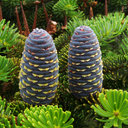Multifunctional Phytocompounds in Cotoneaster Fruits: Phytochemical Profiling, Cellular Safety, Anti-Inflammatory and Antioxidant Effects in Chemical and Human Plasma Models In Vitro.
Schlüsselwörter
Abstrakt
The work presents the results of an investigation into the molecular background of the activity of Cotoneaster fruits, providing a detailed description of their phytochemical composition and some of the mechanisms of their anti-inflammatory and antioxidant effects. GS-FID-MS and UHPLC-PDA-ESI-MS3 methods were applied to identify the potentially health-beneficial constituents of lipophilic and hydrophilic fractions, leading to the identification of fourteen unsaturated fatty acids (with dominant linoleic acid, 375.4-1690.2 mg/100 g dw), three phytosterols (with dominant β-sitosterol, 132.2-463.3 mg/100 g), two triterpenoid acids (10.9-54.5 mg/100 g), and twenty-six polyphenols (26.0-43.5 mg GAE/g dw). The most promising polyphenolic fractions exhibited dose-dependent anti-inflammatory activity in in vitro tests of lipoxygenase (IC50 in the range of 7.7-24.9 μg/U) and hyaluronidase (IC50 in the range of 16.4-29.3 μg/U) inhibition. They were also demonstrated to be a source of effective antioxidants, both in in vitro chemical tests (DPPH, FRAP, and TBARS) and in a biological model, in which at in vivo-relevant levels (1-5 μg/mL) they normalized/enhanced the nonenzymatic antioxidant capacity of human plasma and efficiently protected protein and lipid components of plasma against peroxynitrite-induced oxidative/nitrative damage. Moreover, the investigated extracts did not exhibit cytotoxicity towards human PMBCs. Among the nine Cotoneaster species tested, C. hjelmqvistii, C. zabelii, C. splendens, and C. bullatus possess the highest bioactive potential and might be recommended as dietary and functional food products.


